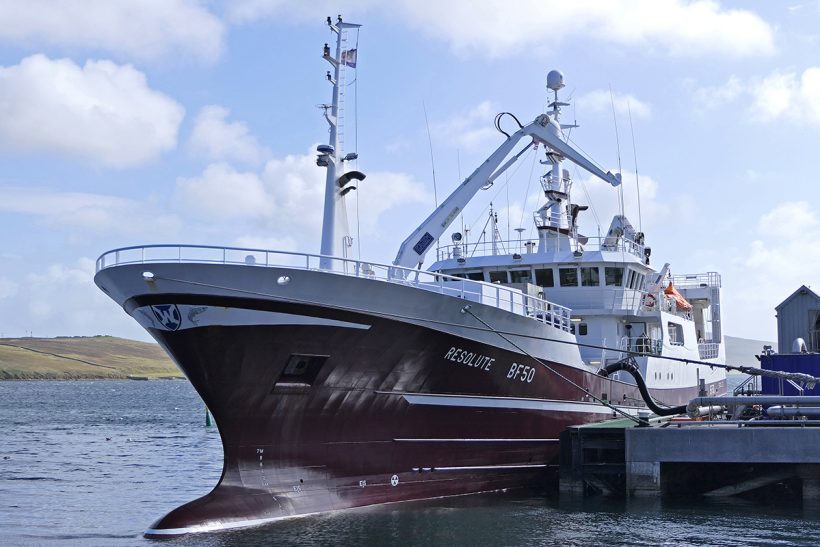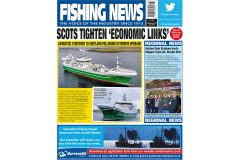Pelagic catchers angry at new consultation.
Scottish pelagic fishermen are angry over new Scottish economic links proposals that will force all Scottish over-10m vessels to land at least 55% of their catches into Scotland, reports Tim Oliver.
Above: The Gardenstown-owned midwater trawler Resolute landing MSC herring for processing by Pelagia Shetland Limited at Lerwick earlier this month. (Photo: Sydney Sinclair)
Marine Scotland has launched a consultation on the plans that will run until 31 October. Marine Scotland has launched a consultation on the plans that will run until 31 October.
The new proposals are aimed at all Scottish vessels. Pelagic ships will have to land at least 30% of their catches into Scotland in 2018, rising to 40% in 2019 and 55% by 2020. All other vessels will have to land 55% of their catches into Scotland from 2018. New economic links licence conditions will be introduced in January 2018 if the proposals go ahead.
Although the changes apply to all Scottish vessels, they are seen as being primarily directed at the pelagic fleet. The sector was in dispute with Marine Scotland earlier this year when Scottish fisheries minister Fergus Ewing withheld a percentage of 2017 pelagic quotas in a bid to persuade Scottish pelagic vessels to land more of their catches to Scottish processing plants.
The Scottish Pelagic Fishermen’s Association (SPFA) said the changes added to the already heavy regulations vessels have to contend with, and were the wrong approach. But the Scottish Pelagic Processors Association (SPPA) said they welcomed the move.
Announcing the consultation, Scottish fisheries minister Fergus Ewing said: “With the value of fish landed by Scottish vessels at a record high of £563m, we need to make sure that the whole industry – whether that’s skippers, harbours, boat builders or fish processors – can benefit from this food and drink success story.“
A Scottish landings target will provide the wider fishing industry with increased security for the future with more vessels landing at least 55% of their fish into Scotland. A more secure supply will allow the processing sectors to work more closely with the catching sector to plan and deliver investment for the future, which is essential to inclusive growth in our coastal communities.
“While the vast majority of Scottish vessels already land well more than half of their fish in Scotland, encouraging our fishermen to land more of their catch here will create jobs and support local businesses in communities on the islands and in the north east of Scotland.”
Under current Scottish licence conditions, over-10m vessels must land more than two tonnes of quota species annually to demonstrate ‘a real economic link’ to the UK, and ensure that the UK benefits from UK quotas.
The economic link conditions were originally introduced to ensure that foreign-owned flag ships fishing against UK quotas had genuine economic links to the UK. A ‘real economic link’ can currently be demonstrated by vessels fulfilling one of the following conditions:
● making 50% of annual quota landings into the UK
● having at least 50% of crew normally resident in the UK, Channel Isles or Isle of Man
● by incurring 50% of operating expenditure in the UK, Channel Isles or Isle of Man
● Various combinations of the above
Vessels also have the option of making quota gifts in lieu of meeting the other criteria.
The proposed new ‘real economic link’ to come into force in January 2018 stipulates that relevant vessels ‘must ensure that there is a real economic link between the fishing activities of the vessel and the communities in Scotland which are dependent on fisheries and related industries’.
The options to satisfy the economic link are now limited to landing 55% of all quota stocks into Scotland (30% initially for pelagic stocks) or other unspecified criteria which provide ‘a real economic link’.
Marine Scotland says there are normally three groups of Scottish vessels that do not routinely make more than half of their landings into Scotland:
● A small number of demersal vessels owned by non-Scottish companies that land into Spain or other parts of Europe
● A small number of generally Scottish-owned demersal vessels that sometimes split their landings between Scottish ports and ports in Northern Ireland and/or England
● Pelagic vessels that land a high proportion of their catch abroad
These groups each year total about 25-35 vessels, or less than 10% of the 400 or so Scottish vessels whose landings of quota species each year normally exceed two tonnes.
The consultation is available here.
SFPA: ‘More regulation is not the answer’
Ian Gatt, chief executive of the Scottish Pelagic Fishermen’s Association (SPFA) told Fishing News:
“Firstly, people right across our fishing industry agree that increasing the amount of pelagic fish landed at home by the Scottish fleet would be a good thing. But the means by which we try to do that are hugely important.
“What the Scottish government has failed to recognise is that there is a genuine issue with processing capacity, which is particularly acute in the January mackerel season. Legislation dictates that fishermen must land at least 40% of their mackerel quota during this period. That means the entire fleet is fishing at this time and all looking to land at the same time. With just four factories in Scotland, this makes it an impossible ask from the government. We’ve heard nothing about how they are going to resolve this.
“Imposing a legally enforceable target on an industry that is already top-heavy with regulation is simply the wrong way to go about it, especially when the trajectory of home landings is already upwards, thanks to the engagement that has recently taken place between the catching and processing sectors.”
The Association has written to Fergus Ewing to say the catching sector is against a regulatory approach to increase pelagic landings into Scotland.
“Why is the Scottish government set on interfering in this market by adjusting the economic link condition, when its actors are already attempting to correct the failure?” asked the SPFA.
“Looking to the future and the post-Brexit era for fisheries, it is clear that considerable additional quota will rightfully be restored to this country – quota that we have, for 40 years, been legally obliged to give away.
“Undoubtedly, much of that additional quota will be landed in Scotland, giving a significant boost to the processing sector. We are thinking here about fattening the goose when a golden one is just about to land.”
But the Scottish Pelagic Processors Association (SPPA) welcomed the consultation, and had been pushing Marine Scotland to act ‘for quite a long time’.
Chairman/secretary Ian McFadden told Fishing News: “We’ve got five fairly large pelagic factories in NE Scotland and Shetland and they have been under-supplied for some time – the Shetland Catch factory is owned by the Norwegians, which is basically a consequence of not getting enough fish.
“It was a manifesto pledge by the SNP in the last election, so they had to do something about it.
“We have been asking both the major POs (SFO and Shetland) to talk about the situation since our first meeting with Marine Scotland in September last year, but they have rebuffed us all the time. They have got the responsibility for marketing their members’ fish but they’ve refused to talk.”
Ian McFadden said a recent report had indicated that for every £1 of fish sold the multiplier effect of processing and adding value increased its value by 65% to local communities.
The SFO declined to comment, and said it would consider its response to the consultation in the light of an independent report on the issue it had commissioned, which is due to be finalised soon.
Read more from Fishing News here.






